42 standard labels for chemical containers
› Avery-UltraDuty-WaterproofAvery UltraDuty GHS Chemical Labels for Laser Printers ... Buy Avery UltraDuty GHS Chemical Labels for Laser Printers, Waterproof, UV Resistant, 2" x 4", 500 Pack (60505), White: Everything Else - Amazon.com FREE DELIVERY possible on eligible purchases › hazcomHazard Communication - Overview | Occupational Safety and ... The Hazard Communication Standard (HCS) is now aligned with the Globally Harmonized System of Classification and Labeling of Chemicals (GHS). This update to the Hazard Communication Standard (HCS) will provide a common and coherent approach to classifying chemicals and communicating hazard information on labels and safety data sheets.
4 Quick Tips to Help You Ace OSHA Secondary Container Labeling OSHA labeling requirements for secondary containers (that do not qualify for exemption) are outlined in HazCom standard 1910.1200 (f) (6) (ii) and summarized listed below. Product Name/Identifier. This should match the product identifier on the safety data sheet. General Hazard Statement.
Standard labels for chemical containers
Rules for Proper Secondary Container Labeling - HSI Storage bottles for solutions or dilutions of a chemical. Sample vials or sealable tubes. Large batches of the same compound may be labeled collectively, provided that they are stored and handled as a group. Exceptions. Only a few exceptions apply to secondary container labels. These include: If the container size is impractical to house a label. Container Labeling: A Key to Compliance - Occupational Health & Safety Containers also must have the following identification on the container, label or tag [29 CFR 1910.1200 (f) (1)]: The identity of the hazardous chemical Appropriate hazard warnings The name and... › msds › oshaOSHA Hazard Communication Standard, 29 CFR 1910.1200 at ILPI Chemical manufacturers, importers, distributors, or employers who become newly aware of any significant information regarding the hazards of a chemical shall revise the labels for the chemical within six months of becoming aware of the new information, and shall ensure that labels on containers of hazardous chemicals shipped after that time ...
Standard labels for chemical containers. Chemical Container Labeling - Northwest Safety Here are some of the key requirements to be aware of: All labels must have pictograms, a signal word, hazard and precautionary statements, the product identifier, and supplier identification. Workplace labels must be provided in English. Other languages should be added to the label if applicable or necessary. Labeling of small containers in the laboratory | Occupational Safety ... The Laboratory standard requires that labels on incoming containers of hazardous chemicals not be removed or defaced, per paragraph 1910.1450 (h) (1) (i), but does not have a specific labeling requirement for secondary containers of hazardous chemicals in a covered laboratory. Chemical Container Labeling - Environmental Health and Safety Hazardous chemical containers used within a Laboratory Area must follow the OSHA Laboratory Standard. Hazardous chemical containers used within a Non-Laboratory Area must follow the OSHA Hazardous Communication ... o Label the outside of the container with approximate contents if feasible or list where more information can be Safety Labels for Hazardous Chemicals | NSTA • Labels on containers used for storing hazardous chemicals must include the chemical identification and appropriate hazard warnings. • The contents of all other chemical containers and transfer vessels, including beakers, flasks, reaction vessels, and process equipment, should be properly identified. Collection and storage of waste
ohs-workplacelabels | Environmental Health & Safety | Washington State ... Workplace Labels for Chemicals. Washington Administrative Code (WAC) 296-901, Hazard Communication Standard, states that all hazardous chemical containers in the workplace must be labeled.This includes secondary, or workplace, containers into which chemicals have been transferred from the shipped, or manufacturer's container (e.g. cleaners/disinfectants transferred to spray bottles). › title8 › 5194California Code of Regulations, Title 8, Section 5194. Hazard ... Sep 28, 2018 · (11) Manufacturers, importers, distributors, or employers who become newly aware of any significant information regarding the hazards of a chemical shall revise the labels for the chemical within six months of becoming aware of the new information. Labels on containers of hazardous chemicals shipped after that time shall contain the new ... PDF Chemical Container Labeling - Environmental Health and Safety Summary of OSHA standards and labeling requirements for Hazardous Chemical Containers Laboratory Areas & Use Non-Laboratory Areas & Use (machine shop, paint shop, etc.) Required Label Information 1 Manufacturer's container 2 Secondary container 3 Manufacturer's container Secondary container Chemical Identity 4 en.wikipedia.org › wiki › Hazard_symbolHazard symbol - Wikipedia A chemical hazard symbol is a pictogram applied to containers of dangerous chemical compounds to indicate the specific hazard, and thus the required precautions. There are several systems of labels, depending on the purpose, such as on the container for end-use, or on a vehicle during transportation.
6 Tips To Ensure GHS Compliance For Small Chemical Container Labels 2) Label all secondary containers. If a chemical is supplied to the workplace with a GHS label, it must be maintained. If the chemical is transferred to a secondary container, such as a tank or spray bottle that stays in the workplace, employers may label it with information from the original GHS shipping label or safety data sheet. Requirements for Shipped Container and Workplace Labels Requirements for Shipped Container and Workplace Labels As part of the 2012 revision of the Hazard Communication Standard, 29 CFR 1910.1200, OSHA adopted new hazardous chemical labeling requirements for shipped containers that align with the United Nations' Globally Harmonized System (GHS) of Classification and Labeling of Chemicals. Chemical Container Labeling - Laboratory Safety Secondary Chemical Containers (e.g., squirt bottle, non-original screw-top bottle, vials, flasks, etc.) must have a means of communicating (1) their contents and (2) the hazards of those contents, either on the container or in the area where the container is stored/used. Use these methods to label your secondary chemical containers: Container Labeling | Office of Environmental Health and Safety | ECU Labels of incoming manufactured products or chemicals must contain 6 key elements: Signal Word Pictograms Manufacturer Information Precautionary Statement(s) Hazard Statement(s) Product name or identifiers OSHA requires that labels on incoming containers of hazardous materials must not be removed or defaced until the container is empty and rinsed.
› sites › defaultBRIEF - Occupational Safety and Health Administration Hazard Communication Standard: Labels and Pictograms standard also requires the use of a 16-section safety data sheet format, which provides detailed information regarding the chemical. There is a separate OSHA Brief on SDSs that provides information on the new SDS requirements. All hazardous chemicals shipped after June 1,
› chemical › mychemMyChem | EHS They help the University comply with federal, state and local hazardous material regulations, including Hazardous Material Storage and Use Permits, Hazard Communication, Community Right-To-Know and the Chemical Facility Anti-Terrorism Standard. MyChem can also be used to: Generate a chemical waste collection request
Chemical Container Labels | EHS Dev The label on an original chemical container must be legible and written in English. It must include the chemical/product name as shown on the SDS and the manufacturer's name and address. Do not accept materials if the label is illegible or missing required information. (See example of original label below).
Hazard Communication Standard Labels All labels are required to have pictograms, a signal word, hazard and precautionary statements, the product identifier, and supplier identification.1 page
Container Labels Reading and work safely-Safety Poster - HSSE WORLD GHS Labels for Primary Containers Primary chemical containers are the bags, barrels, bottles, boxes, cans, cylinders, and drums that you receive from the manufacturer. These containers should be labeled following the GHS mandates per the GHS label example above and include all six labeling elements.
GHS Labeling Requirements: The Definitive Guide [2021 Update ... - Luminer However, the GHS takes into consideration that, sometimes, it's not possible to keep workers safe with only these six label requirements, which is why it also allows for supplemental information. 1. Product Identifier This requirement identifies the actual hazardous chemical inside the container.
Primary Container Label Requirements - Quality OSHA Training Shipped - Primary Container Label Requirements. Under the new HCS 2012, labels on containers shipped from manufacturers ...
Chemical Container Labeling - Environmental Health & Safety Services ... Chemical Container Labeling. In accordance with OSHA's Hazard Communication Standard, manufacturers, importers or distributors of hazardous chemicals must follow specific container labeling requirements when their product are shipped in commerce. ... The University must ensure manufacturer container labels are maintained in good condition and ...
Chemical Container Labels | EHS The label on an original chemical container must be legible and written in English. It must include the chemical/product name as shown on the SDS and the manufacturer's name and address. Do not accept materials if the label is illegible or missing required information. (See example of original label below).
GHS Labels for Secondary Containers | HCL Labels, Inc. HCL Labels, Inc. offers a library of over 800 ready-made chemical GHS labels for secondary containers. GHS-labeled secondary containers are required by state and federal law to be labeled with a GHS Safety label, indicating which chemical is in use. ... and the OSHA HazCom Standard. Have questions, custom requests, or can't find what you're ...
Chemical Hazardous Waste Containers: EPA and DOT Labeling Requirements A container used for chemical hazmat onsite storage must be marked with the words "Hazardous Waste." It must also exhibit the starting date for its accumulation along with information about its contents (e.g., toxic, reactive, ignitable, or corrosive). If you're reusing a container, make sure to remove the old labels.
NMSU Chemical Container Labeling Procedures The original manufacturer label must remain legible at all times. If the original label is damaged, removed or defaced the label must be replaced immediately with a new label containing the same information. Workplace (Secondary) Container Labeling. During routine laboratory or shop operations, hazardous chemicals are frequently transferred ...
Types of Containers and Labels - Quality OSHA Training Container labeling can be a very effective method to communicate the physical and health hazards of chemicals used in the ...
GHS Container Labels | EHS | Research Administration GHS Container Labels. OSHA has adopted the new hazardous chemical labeling requirements as part of the effort to harmonize with the United Nation's Globally Harmonized System (GHS) of Classification and Labeling of Chemicals. The new label provides information to workers on the specific hazardous chemical. The container limits the label size ...
PDF CHEMICAL CONTAINER LABELING GUIDELINES - Towson University All chemical containers must be labeled. The only exception is portable containers under the explicit control of the user at all times. If the container will be left alone for any reason, then it must be labeled. Per the OSHA Hazard Communication Standard 29 CFR 1910.1200, the primary information on an OSHA-required label is the identity of the
Labeling of Secondary Containers | Occupational Safety and Health ... section 1910.1200 (f) (6) (ii) requires that workplace labeling include "product identifier and words, pictures, symbols, or combination thereof, which provide at least general information regarding the hazards of the chemicals, and which, in conjunction with the other information immediately available to employees under the hazard communication …
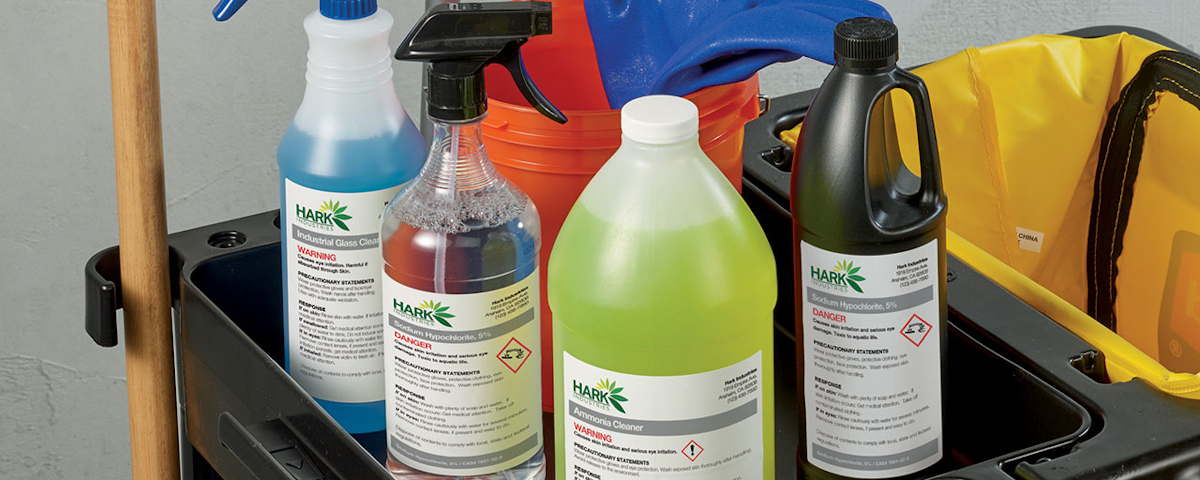
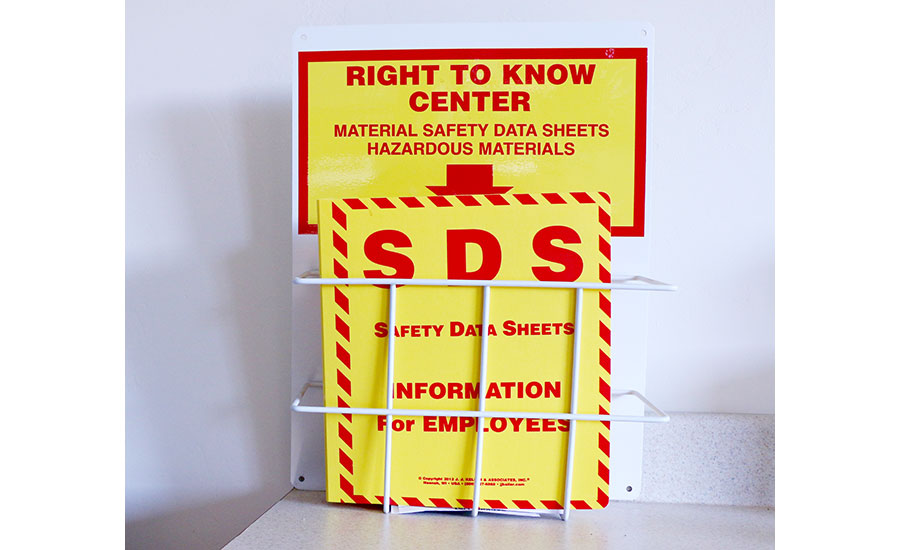

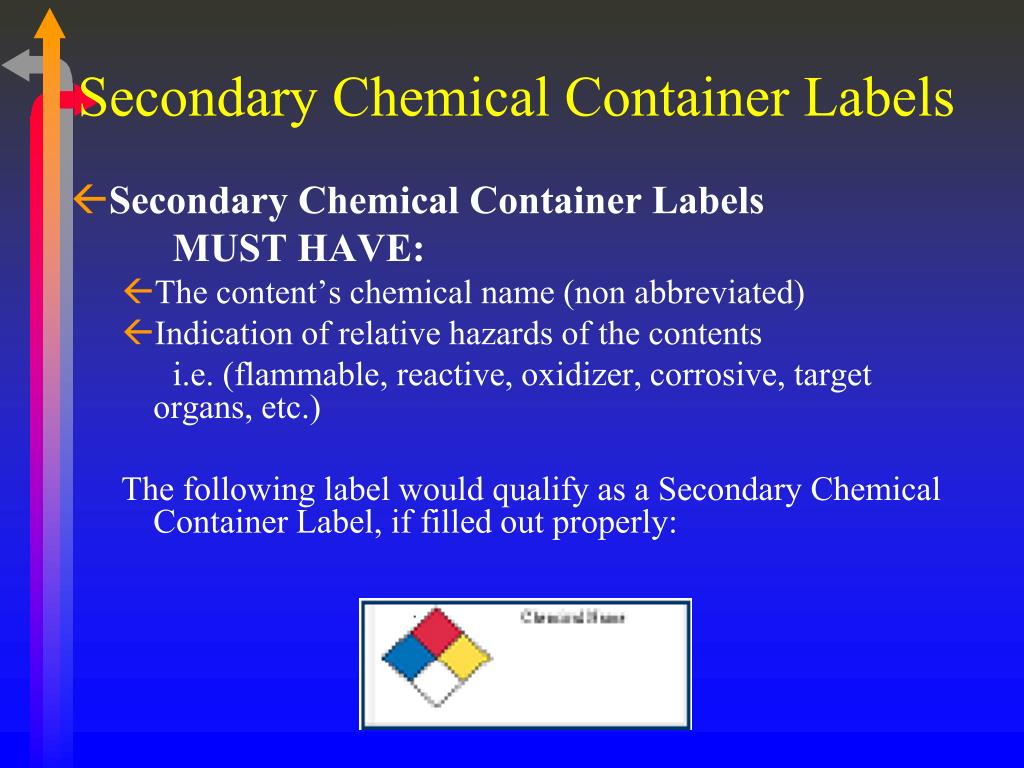

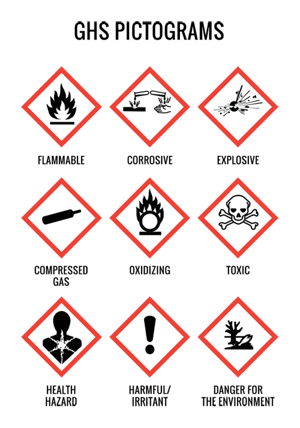


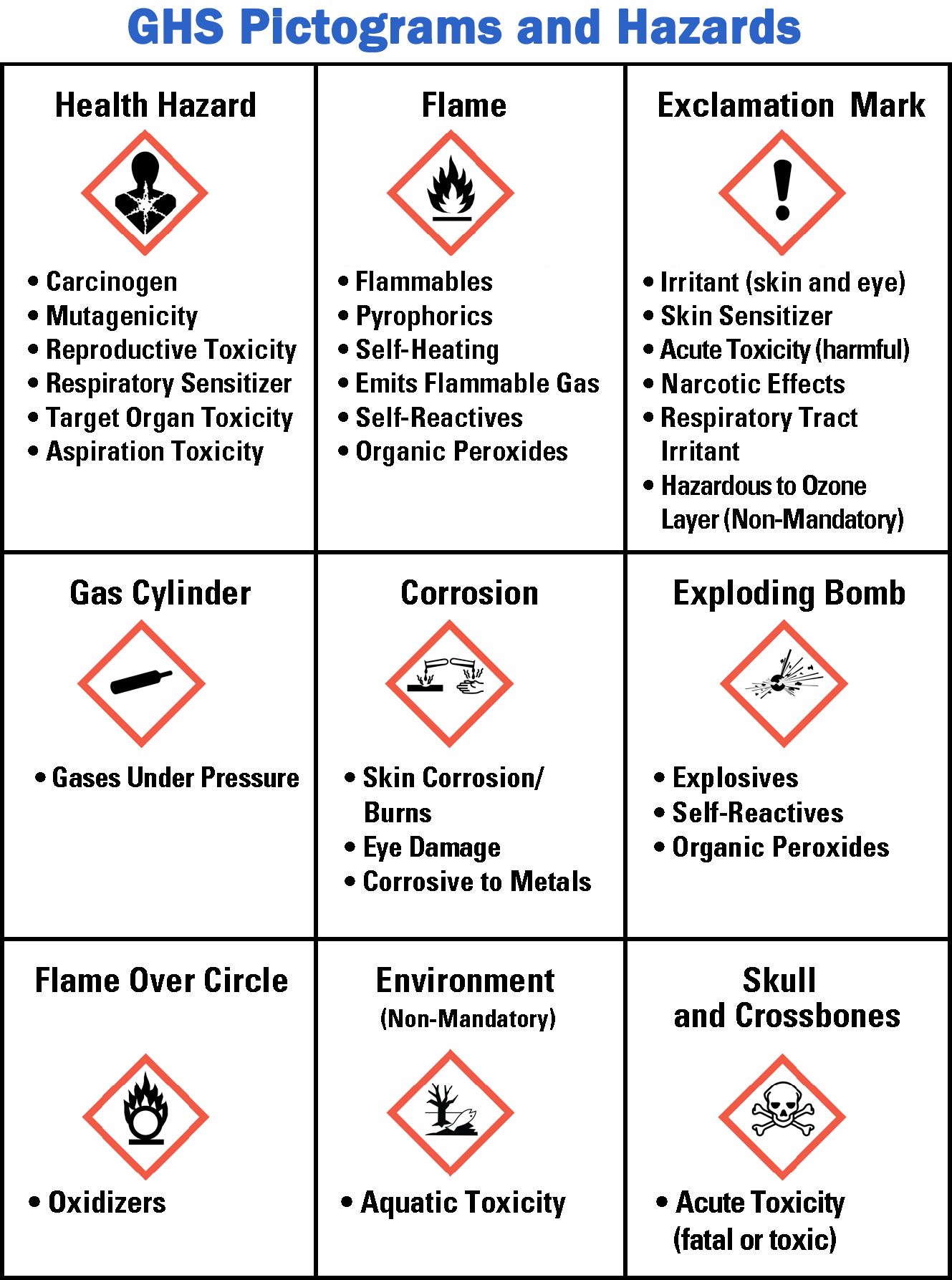
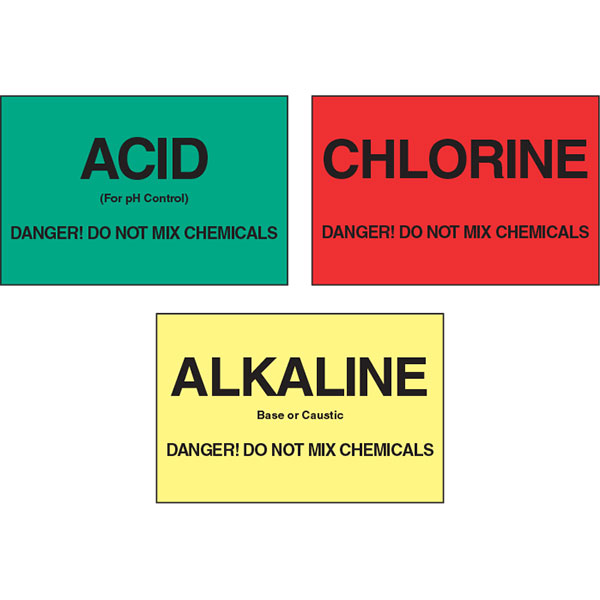
Post a Comment for "42 standard labels for chemical containers"